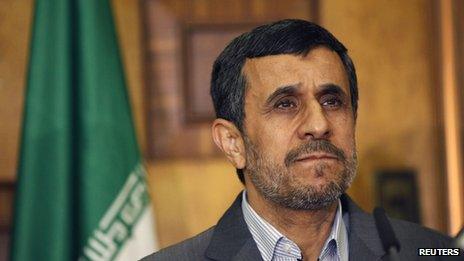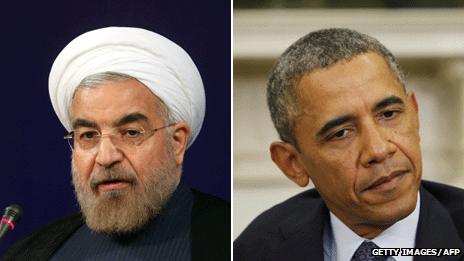How letter diplomacy keeps Iran and US 'talking'
- Published
President Obama told ABC News he had 'reached out' to Iran's new president
The way that US and Iranian leaders communicate, you might think that telephones, faxes, and emails have yet to be invented. Or even stamps.
Iran's seizure of the US embassy in Tehran in November 1979 caused the US to break off diplomatic relations. For the last 34 years, the two countries have been opponents. But, in recent years, the country's respective leaders have managed to send each other occasional letters delivered through intermediaries.
The tradition appears to have begun in 2006 when Iran's President, Mahmoud Ahmadinejad, wrote an 18-page letter to his US counterpart.
"Mr George Bush, President of the United States of America," Mr Ahmadinejad wrote.
"For sometime now I have been thinking, how one can justify the undeniable contradictions that exist in the international arena - which are being constantly debated, especially in political forums and amongst university students."
The White House debated how to respond to the letter.

'Rambling': Former Iranian President Mahmoud Ahmadinejad wrote to President George Bush in 2006
"My recollection is that it was a rambling letter and when the question came up, well shall we reply to the letter, one of the problems was it's hard to know what to reply to, it was just a sort of rambling, sort of stream of consciousness," President Bush's National Security Advisor Steve Hadley told the BBC for a documentary on President Ahmadinejad.
"Our response was to try and respond to the letter by speaking to the Iranian people."
So the Bush administration never wrote back to Mr Ahmadinejad. But the political atmosphere in America was changing.
During a debate among Democratic presidential candidates in 2007, Senator Barack Obama was was asked if he would meet the leaders of Iran, North Korea, Cuba, Syria, and Venezuela without preconditions during his first year of office.
Mr Obama said that he would.
"It is a disgrace that we have not spoken to them," he added.
'Naive'
Mr Obama's rival for the nomination, Hillary Clinton, criticised his position as "irresponsible and frankly naive".
But Barack Obama won the nomination and the election. Once he took office, he tentatively explored fulfilling his promise.
In May 2009, the US president decided to bypass Mahmoud Ahmadinejad, who was widely seen as a powerless controversialist.

Lines of communication: Hassan Rouhani and Barack Obama are the latest Iranian-US leaders to exchange letters
Instead, Mr Obama wrote directly to Iran's Supreme Leader, Ayatollah Ali Khamenei - the country's final decision maker. But this did not develop into a lasting correspondence.
A few weeks after the letter arrived, Iran held disputed presidential elections. The atmosphere between the US and Iran worsened.
Engagement
But Hassan Rouhani's election as Iran's president in June this year changed things. The new president promised moderation and serious engagement with the outside world.
It was enough to provoke Mr Obama into picking up his pen again. The two presidents have now exchanged letters.
The Guardian newspaper speculates, external that the two men may decide to meet at the United Nations in New York later this month when the two attend the annual session of the General Assembly.
Each man has a lot to gain from a direct meeting. The two presidents have promised to find ways of ending the 11-year long dispute over Iran's nuclear ambitions.
But holding a presidential-level meeting without preparation or immediate result may open each man to criticism at home.
It may be that an encounter between the US Secretary of State, John Kerry, and Iran's Foreign Minister, Mohammad Javad Zarif, is a more likely first step.
Failing that, each side can always write another letter.
- Published15 September 2013
- Published15 August 2013
- Published30 August 2013